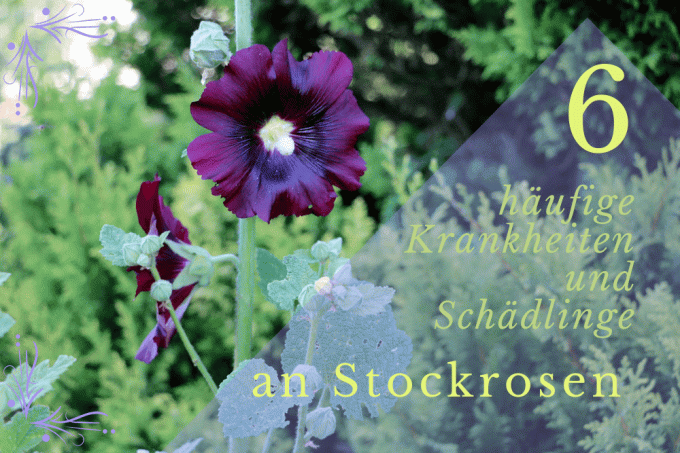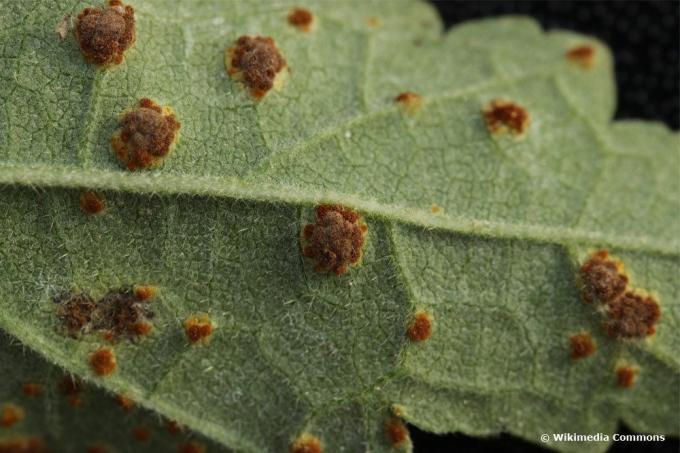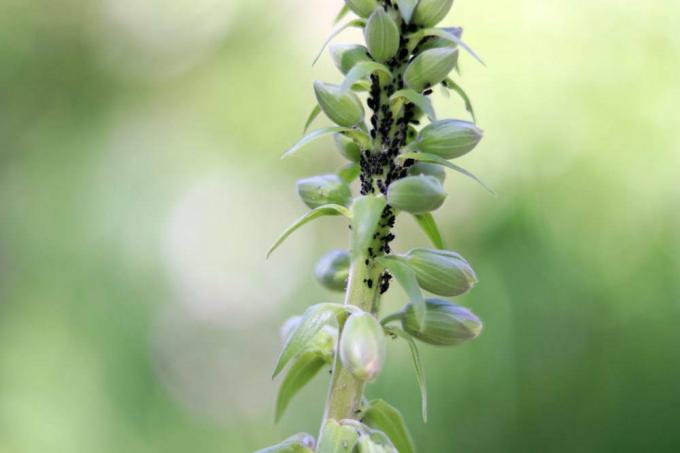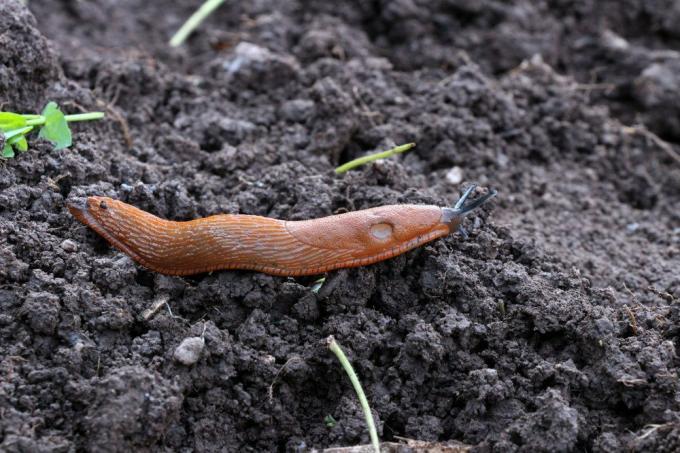
table of contents
- Largely resistant to diseases
- Mallow rust
- Wilt disease (Phoma)
- Mallow Flea Beetle
- Aphids
- Snails
- Mallow shrew
Hollyhocks (Alcea), the beauty from the Orient, have also become at home in many gardens in this country. Its flowers in the most beautiful colors from white to yellow, pink, red to dark purple shine from July until late October. Due to their size, the decorative plants are visible from afar. The hollyhock is easy to care for and also very robust, but it can also be attacked by various diseases and pests.
Largely resistant to diseases
As a rule, hollyhocks are very easy to care for and robust against diseases and pests. In a sunny, slightly moist location with fresh and nutrient-rich soil and a sufficiently large distance between plants, diseases and pests have a hard time settling. Proper care is also important with regard to sufficient supply of nutrients and water. Nevertheless, one or the other disease can affect the growth and bloom of the hollyhocks. It is therefore important to detect even the smallest damage to the alcea early in order to avert greater damage to the plant. The most important diseases and pests are listed below.
Mallow rust

Mallow rust is widespread and can cause great damage to hollyhocks and other plants without treatment. It is a fungal disease with Puccinia malvacearum, which can appear in early spring. The symptoms are as follows
- yellow-red pustules on the underside of the leaf
- contain spores of the fungus
- yellow-brown spots
- can also appear on petioles and stems
In the course of the disease, the leaf tissue of the hollyhocks turns yellow at first, then brown later. The leaves begin to wither and eventually fall off. One cause of the development of the fungal disease is the prevailing humid and warm weather over a longer period of time in summer. In addition, the disease is also favored by
- too close planting distance
- very high humidity
- poor air circulation between plants
- Leaves cannot dry off properly
Primarily biological home remedies should be used to combat it, for example
- Broth made from compost
- Onion stock
- Garlic tea
- Broths made from tansy, field horsetail and yarrow
Infested leaves should be removed regularly and disposed of in the general waste, never on the compost. There is a risk of further spread here. However, if all parts of the plant are infected, the only thing that will help is to completely dig them out, including the roots. The disposal is then also in the residual waste or is incinerated.
To avoid mallow rust, preventive measures are also important, such as
- Avoidance of waterlogging
- regular loosening of the soil
- adequate potassium fertilization
- use of rhubarb stock
- Minimum plant spacing 50 centimeters
- sunny, moderately dry location
- water from below
Note: The mallow fungus can overwinter in the plant as well as in the ground and break out in spring under favorable conditions.
Wilt disease (Phoma)

Here, too, the cause of this disease is a fungus that damages the inner vessels of the hollyhocks and thereby affects the water balance of the plant. It is no longer able to adequately supply all parts of the plant with water. It slowly begins to wither and eventually dies. The first signs are
- brown spots on leaf margins
- slowly cover the entire sheet
- Spots turn black
- it contains spores of the fungus
In the event of an infestation, the hollyhocks wither from below. The oldest leaves are always attacked first. As a rule, infected plants can hardly be saved. In the event of an infestation, care must be taken to ensure that other plants are not infected. Solution to the problem are
- complete removal of the infected plant
- complete excavation of the root with soil
- Exchange the earth around the plant
- Fungal spores overwinter in the soil
- Disposal in residual waste
- not on compost - risk of spreading
- Always watering from below
- Minimum plant spacing 50 centimeters
- fertilize calibrated
- regular soil loosening
Mallow Flea Beetle

The beetle (Podagrica fuscicomis), also known as the mallow flea, is not a disease, but a pest, but it can also affect hollyhocks. It lays its eggs in the stems of the plants. From there, the brownish-blue hairy larvae eat their way into the pulp or the roots. Eventually they migrate into the ground to hibernate there. One of the most common causes of earth flea occurrence is too dry soil. The beetle reaches a size between three and six millimeters. Are characteristic
- blue-green to black coloring and
- yellow-red head and legs
First signs of the presence of the beetle are expressed as follows
- Occurring May to June
- sieve-like perforation of the leaves
- so-called skeletal damage
- often only leaf veins remain
- infestation of buds and flowers is also possible
Immediate treatment of the plants is then necessary, otherwise the entire plant population can quickly become infected. First measures should be
- Dispose of infected leaves in the residual waste
- not on compost - risk of spreading
- Collecting the beetles
- regular loosening of the earth
- water regularly
- Do not wet leaves
Note: Many hobby gardeners swear by the use of matches. These are put into the soil around the plant with the head.
Aphids

Mainly these pests appear in spring. They are then abundant on fresh shoots. The aphids (Aphidoidea) can be up to seven millimeters in size. The existing proboscis with which they suck out the sap from their victims is typical. For the most part, this juice is then excreted as a sticky liquid, the honeydew. This covers buds, flowers and leaves and attracts insects such as ants. Hollyhocks, like other plants, are particularly susceptible to diseases such as sooty mildew. Treatment must be carried out immediately after the aphids appear, otherwise the plants will be seriously damaged.
One solution can include the use of natural predators such as ladybirds, parasitic wasp larvae or hover fly larvae. Good results are also achieved with spraying Nettle stock or a lye made from curd soap and water. Application in the morning has the best effect.
Snails

Snails (Gastropoda) can also be a dangerous nuisance for hollyhocks. They prefer to eat the tender, young leaves in the spring after they have sprouted, thus hindering the growth of the plants. As soon as the first damage occurs, control must take place, otherwise the plants can hardly be saved. Measures can be
- collecting the snails in the evening
- Spreading slug pellets
- Beware of pets and children
- alternatively erection of snail barriers
Sawdust, sand or coffee grounds are ideal for this. These materials are simply sprinkled around the plants. Coffee grounds are also a good fertilizer.
Mallow shrew

It can quickly be assumed that this is a mouse, but completely wrong. The mallow shrew (Rhopalapion longirostre) is a beetle. Your pointed trunk is responsible for its naming. Without a trunk, it is between 2 and 3 millimeters in size
- black with thick white-gray hairs
- Legs reddish yellow
- Trunk length of body
The females lay the eggs between June and July on the stems and mainly in the flowers. The hatched larvae then dig deep into the ovary. As a result, the buds dry up. But not only can an infestation be recognized in this, but also in
- eaten shoot tips
- dried up flower buds
- Eating damage to leaves
If there is an infestation, few flowers are to be expected. Treatment then becomes necessary. To do this, the eggs and beetles must be regularly collected and affected and dried-up parts of the plant removed.
Note: It is not only important to combat the disease or pests on the hollyhocks, but the cause must be identified and eliminated.



